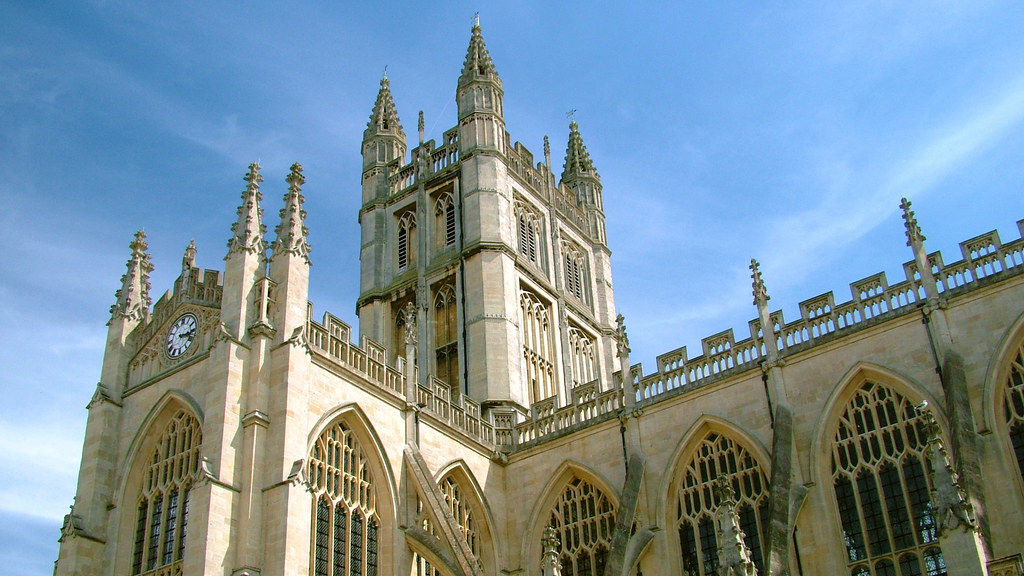Installing solar panels could help historic buildings beat the rising costs of energy, according to a new study by a team of UK researchers led by the University of Bath.
- Feasibility study estimates installing solar panels on Bath Abbey could save around 10 tonnes of carbon dioxide per year – the weight of an African elephant or equivalent to an average car driving almost twice the circumference of the Earth.
- Solar panels could produce enough electricity to cover 35% of the Abbey’s usage.
- Study demonstrates that using solar panels could significantly reduce the carbon footprint of key heritage buildings that are difficult to insulate.
Researchers from the Centre for Doctoral Training in New and Sustainable Photovoltaics – a consortium of seven universities led by the University of Bath that trains doctoral students in different aspects of solar energy technology – looked at the dimensions, tilt and orientation of the Abbey roof, along with historic weather data, and shading of the roof from spires, to model the best configuration for 164 photovoltaic (PV) panels and estimated the amount of electricity that could be generated in a normal year.
They found that the set up could produce around 45 Mega-Watt hours per year, which accounts for roughly 35% of the Abbey’s annual usage. The equivalent amount of carbon dioxide saved, versus buying the electricity from the National Grid, would be around 10 tonnes per year, significantly reducing the carbon footprint of the building.
A cost-benefit analysis showed that the system could pay for itself in 13 years and provide a profit of £139,000 over a lifespan of 25 years. It would also future-proof the Abbey from rising costs of energy bills. The findings show that despite a large initial outlay, the system would be financially feasible for the historic grade I listed building.
They have published their findings in the journal Energy Science & Engineering.
Matthew Smiles, PhD researcher at the University of Liverpool who is first author on the study, said: “It’s very difficult to insulate historic Grade I listed buildings like Bath Abbey, so installing solar panels is a good way to reduce the carbon footprint of these buildings.
“Most of the Abbey’s electricity is used during the day, when the solar panels would be generating energy from sunlight, making it an ideal building to implement them.
“With increasing energy prices, installing solar panels could result in large cost savings.”
In the model, the panels were sited such that they couldn’t be seen from the street, only from a distance from the Bath Skyline, so would have minimal visual impact on the historic building.
Professor Alison Walker, Director of the Centre for Doctoral Training in New and Sustainable Photovoltaics at the University of Bath’s Department of Physics, has collaborated with Bath Abbey for several years on the project.
She said: “This paper is an amazing collaboration between the PhD students and the Bath Abbey Footprint Project who first invited us to look into solar for the Abbey and arranged for the students to visit the Abbey roof to see how solar could work.
“It’s great for the students, whose research projects are all on solar power, to see a practical application of the training they have done in universities across the UK”.
PhD student Adam Urwick, who performed the abbey modelling, module design and shadings analysis from the University of Sheffield, said: “The proposed installation would generate 45MWh and save about 10 tonnes of CO2 emissions in its first year of generation. This is equivalent to the emissions of an average vehicle driving 80,000km - almost twice the circumference of the Earth.
“Not only does it make financial sense, but the installation of solar panels on Bath Abbey could inspire reinvigoration of solar PV deployment in the UK which has stagnated over the past 5 years.”
The research was performed as part of a feasibility study for the Abbey’s Footprint programme, as part of the Church of England’s campaign, Shrinking the Footprint, which aims to reduce the carbon footprint of its historic buildings.
The Bath Abbey Footprint programme has already reduced its carbon footprint by using the geothermal hot springs of the local area to provide underfloor heating and installing LED light bulbs to illuminate the interior.
Although environmental and planning rules must also be considered carefully, installing solar panels is another potential way the Abbey could reduce its footprint further.
Nathan Ward, Footprint Project Director at Bath Abbey, said: “It’s been fantastic working with the University of Bath and the other universities on this project. The students and staff have shown a high level of commitment, knowledge and enthusiasm and have provided us with well-considered and invaluable research that we would like to use practically in the future.
“The research will help us greatly in exploring the use of solar panels on the Bath Abbey roof. The Abbey is highly committed in the outstanding care of both our built and natural environment and to reduce our carbon footprint.
“This has been achieved in part thanks to our Footprint project which saw the installation of new LED lighting and eco-friendly underfloor heating that uses energy from Bath’s natural hot water, but the use of solar panels would enable us to reduce our carbon footprint further.”
The Centre for Doctoral Training in New and Sustainable Photovoltaics is a consortium of seven universities and 12 industrial partners led by the University of Bath and funded by the Engineering and Physical Sciences Research Council (EPSRC). The universities include: The Universities of Bath, Cambridge, Liverpool, Loughborough, Oxford, Sheffield and Southampton.

